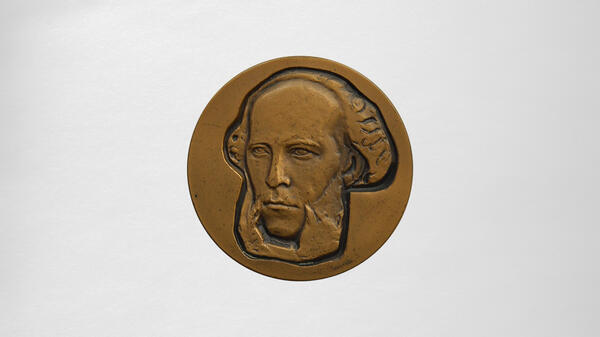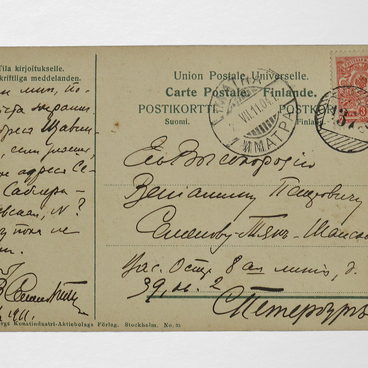The medal was made in 1964 to commemorate the 50th anniversary of the death of Pyotr Semyonov-Tian-Shansky. On the front side, there is a portrait of the scientist from the time of his work in the Commission for the preparation of the Peasant Reform of the 1860s. On the reverse side in the center, there is a ‘Wind Rose’ — a symbol of travel. Around the edge of the medal is an inscription: ‘Semyonov-Tyan-Shansky. 1827-1914.’
The reverse side of the medal is in the shape of irregular relief, reminiscent of the mountain landscape — one of the main interests in the life of the scientist. Semyonov-Tyan-Shansky was one of the first to study the geography of the mountains of Central Asia. In 1856, and in 1857 during the expeditions, he explored more than twenty passes and collected hundreds of samples of rocks, insects, shellfish, and plants. Many of them were unknown to science.
It was produced in 300 copies and was made of metal. The author of the medal was Yurii Neroda, a sculptor from a famous artistic family. His father, Georgy Neroda, was also a sculptor and a member of the Association of Artists of Revolutionary Russia; his mother was an artist, a graduate of the Stroganoff School of Arts and Crafts.
Yurii Neroda was born in 1920 in Chernigov. He graduated from the Art School in Memory of 1905. He created the medal from the museum’s collection after he was seriously concussed in the war in 1941. The war theme was very important for Neroda, he worked scrupulously on portraits of soldiers who fought at the battlefront.
In the 1960s, Yurii Neroda played one of the leading roles in the revival of medallic sculpture in the country. It was at this time that he created the memorial medal depicting Pyotr Semyonov-Tyan-Shansky. There are medals for the 150th anniversary of the composer Franz Liszt, works with portraits of Ivan Krylov and Fyodor Dostoevsky among other items of his medal art.
His best sculptural works also include a monument dedicated to space exploration in Geneva. Neroda was a participant in most of the All-Soviet Union and foreign art exhibitions. His works were honored with prizes and diplomas.
The reverse side of the medal is in the shape of irregular relief, reminiscent of the mountain landscape — one of the main interests in the life of the scientist. Semyonov-Tyan-Shansky was one of the first to study the geography of the mountains of Central Asia. In 1856, and in 1857 during the expeditions, he explored more than twenty passes and collected hundreds of samples of rocks, insects, shellfish, and plants. Many of them were unknown to science.
It was produced in 300 copies and was made of metal. The author of the medal was Yurii Neroda, a sculptor from a famous artistic family. His father, Georgy Neroda, was also a sculptor and a member of the Association of Artists of Revolutionary Russia; his mother was an artist, a graduate of the Stroganoff School of Arts and Crafts.
Yurii Neroda was born in 1920 in Chernigov. He graduated from the Art School in Memory of 1905. He created the medal from the museum’s collection after he was seriously concussed in the war in 1941. The war theme was very important for Neroda, he worked scrupulously on portraits of soldiers who fought at the battlefront.
In the 1960s, Yurii Neroda played one of the leading roles in the revival of medallic sculpture in the country. It was at this time that he created the memorial medal depicting Pyotr Semyonov-Tyan-Shansky. There are medals for the 150th anniversary of the composer Franz Liszt, works with portraits of Ivan Krylov and Fyodor Dostoevsky among other items of his medal art.
His best sculptural works also include a monument dedicated to space exploration in Geneva. Neroda was a participant in most of the All-Soviet Union and foreign art exhibitions. His works were honored with prizes and diplomas.





